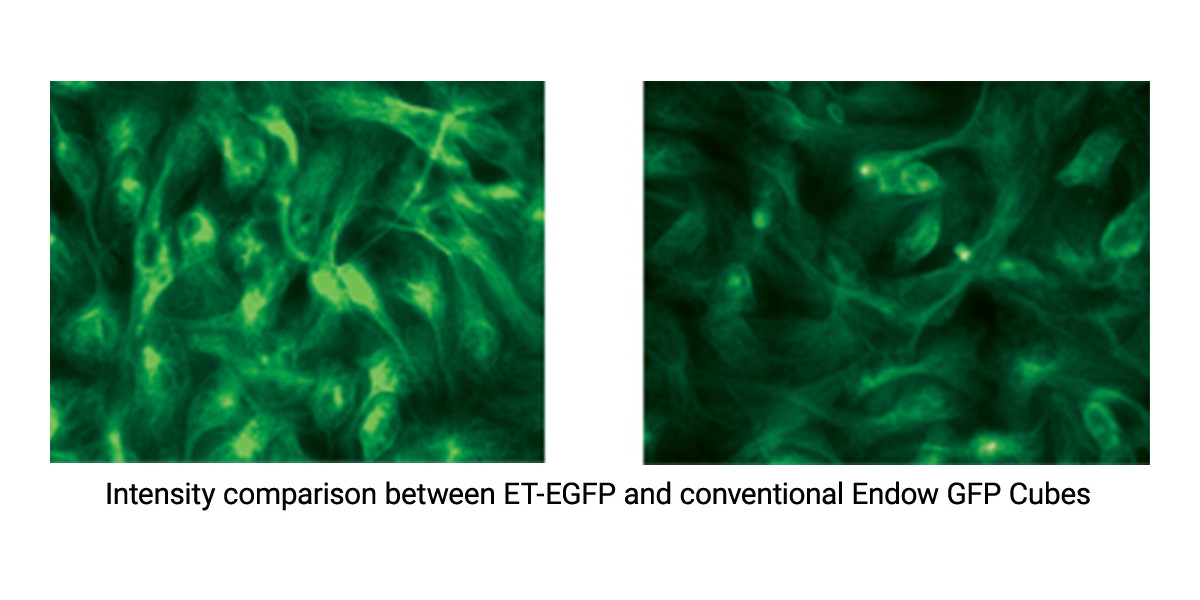
What is the difference between the AT and ET filter sets?
AT filter sets are the perfect choice for routine fluorescence detection and assays, and for most applications requiring accurate color discrimination and excellent out-of-band blocking. ET filter sets are our highest quality option; they have zero-pixel-shift image registration, and are necessary for applications requiring the highest possible signal intensities.
Using an emission filter as an excitation filter
Our excitation filters are made to block all light from 300-1000nm or higher outside of the bandpass. Most of our emission filters do not block light that far out of the transmission band and therefore might pass some unwanted light from your light source to your sample. More importantly, this unblocked excitation light will then be transmitted to the detector.
If using an ET filter, iIt is very important that we make sure the filter is adequately blocking all of the excitation light transmitted to the sample. When filters are requested that are very close in wavelength we look not only at transmission, but at the optical density (blocking) measurements to be sure there will be no unwanted excitation light being transmitted to your detector.
When blocking (attenuation) the emission filter does not sufficiently block all wavelengths of the excitation light, then this light will be transmitted to the detector. Keep in mind that the intensity of the excitation light is many orders-of-magnitude greater than that of the fluorescence emission from a sample labeled with fluorophores. This can appear as anything from a light colored haze to an almost blindingly bright sea of light, obscuring any fluorescence. Furthermore, unblocked excitation light may lead to destruction of equipment or damage to the user’s eyesight.
Do I need an excitation filter with my single-color LED?
Yes, an excitation filter is required. The output of LED light sources is not monochromatic and instead has a Gaussian shaped spectral emission profile. The “tails” of this LED emission often extend >40nm from the peak wavelength and must be excluded from the passband of the emission filter. An excitation filter will block these unwanted wavelengths and transmit only the desired wavelengths to your sample.
Do I need an excitation filter with my laser?
Yes, we do recommend an excitation (laser clean up) filter. Few lasers are truly monochromatic. Gas lasers typically emit several discrete wavelengths and the blocking provided by AOTFs is often insufficient to prevent laser noise in the emission channel. Many laser diodes can have significant bandwidth and should be treated as a broadband source. Also, because laser illumination is very intense, relatively low levels of laser light can dramatically affect the signal/noise ratio of a fluorescence image.
Using a longpass emission filter as a dichroic
All of our filter and dichroic designs are very angle sensitive. Our filters are designed for a zero degree angle of incidence (AOI) and dichroics are designed for a 45 degree AOI (unless otherwise specified). Changing this angle will drastically shift the spectral performance of the part.
Filters for flow cytometry or plate reader applications
Because of the multiplexing typically employed in flow cytometry, you’ll want to use filters which are fully blocked out-of-band up to about 900nm, which is the detection limit of most PMTs. Typically, almost all of our excitation filters and many of our emission filters will work well in these applications. We simply need to know the wavelength range that you want the filters to transmit, the wavelength range of the excitation light (typically laser or LED), and the size of the desired filter.
If you do not see what you need please contact us at sales@chroma.com. We can customize filters to work with your systems.
If you have any questions about our filters please contact Customer Service. Additionally, contact our Sales Team will help you customize filters or recommend a catalog set to work with your application.










